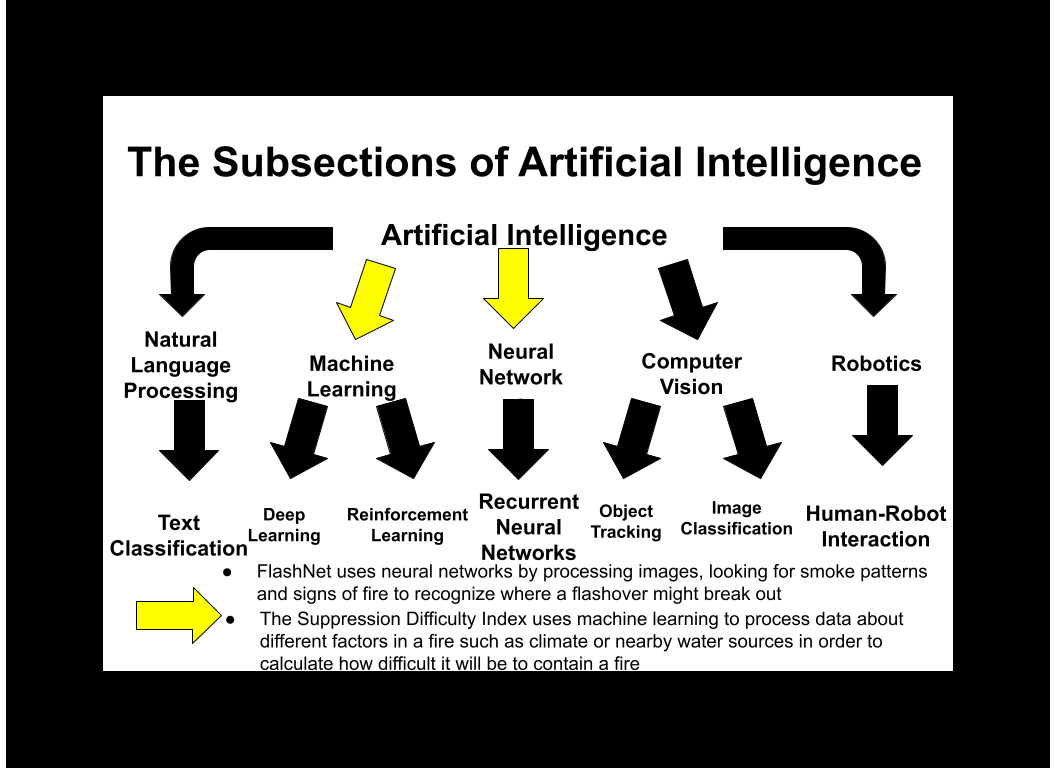Artificial Intelligence (AI) remains a hot topic, with ethical concerns and potential consequences at the core of the discussion. Nonetheless, the integration of AI into nearly every aspect of modern society suggests that AI is here to stay. As society navigates its rocky relationship with AI implementation, it becomes imperative to shift the focus from its potential risks to exploring AI as a tool with the power to save lives. One such positive application is in firefighting, where recent scientific developments have shown AI’s promise.
Artificial intelligence is defined as “a machine-based system that can, for a given set of human-defined objectives, make predictions, recommendations or decisions influencing real or virtual environments” (U.S. Department of State, 2023). AI can then be further broken down into several subsections, with machine learning (ML) and neural networks (NN) being two subsections with important roles in further developing firefighting technology. Machine learning uses algorithms that enable computers to learn from data and improve their performance without explicit programming (Researchgate, 2022). Neural networks mimic the functions of the human brain, typically being used for tasks such as pattern recognition, image processing, and natural language understanding (Researchgate, 2022). These advanced AI models are increasingly used in firefighting: machine learning is used to predict fire behavior, and neural networks are used to analyze fire-related information, ultimately reducing fire-related harm.
One way artificial intelligence is benefitting firefighters is by predicting a fire phenomenon known as a flashover. A flashover is a thermally-driven event in which every combustible surface in an enclosed space simultaneously ignites (U.S. Fire Administration, 2020). Researchers have been developing a Flashover Prediction Neural Network (FlashNet) that foresees a flashover before it occurs. In the past, applying machine learning to firefighting was difficult for scientists because the algorithms had difficulty making accurate predictions in varying environments where fires materialize. Earlier AI tools did not account for the myriad of housing and building types in which the fire might occur, rendering the results inaccurate. Scientists at the National Institute of Standards and Technology and Hong Kong Polytechnic University found a solution to this problem by using neural networks. They recognize patterns based not only on the specific type of structure, but also on real time data such as temperature and smoke. Then, that information is consolidated into a prediction of whether or not a flashover is likely to occur. As a result, FlashNet has an accuracy of 92.1% across a dozen types of residential floor plans (Garrity et al., 2022). Using Flashnet thus helps firefighters gain back crucial seconds before a flashover, evolving firefighting strategies and saving lives.
AI also aids in the fight against wildfires. AI-based tools have been essential in analyzing wildfire behavior, specifically vegetation combustibility and fire spread. One such tool is WIFIRE, which uses satellite imagery to accurately predict fire patterns by considering factors such as wind and precipitation (Surya, 2020). Early detection using WIFIRE allows quicker response times from firefighters and more efficient allocation of firefighting resources. Another noteworthy tool named the Suppression Difficulty Index (SDI) employs statistical models over a land region, assisting fire departments in proactive planning to control potential fires (Asher-Schapiro, 2021). The statistical models use collected data to calculate a number representing the chance of a fire growing out of control in that area. If an area has a higher number, the fire department would use more resources in that region compared to one with a lower number. This additional information allows firefighters to adapt to diverse environments more easily. These AI tools reduce uncertainty and increase safety, expanding firefighters’ strategic decision-making capabilities when fighting fires.
While human judgment is still invaluable when fighting fires, there are limitations to the speed at which humans can assess emergency situations, requiring the incorporation of technology to further enhance safety measures. In 2022, there were 96 firefighter fatalities in the United States alone (Campbell & Petrillo, 2023). This year, there have already been 1,305 home fire fatalities (U.S. Fire Administration, n.d.). AI tools provide real-time updates on fire conditions, helping identify hazardous environments for firefighters. The potential of these AI tools to improve firefighting techniques is significant because it could save countless lives in the future. However, continued testing of these AI tools in controlled environments is necessary to ensure their successful contributions to the field.

References
Asher-Schapiro, A. (2021, July 28). AI is helping scarce firefighters better predict blazes. World Economic Forum. https://www.weforum.org/agenda/2021/07/ai-firefighters-wildfires-statistical-models/
Campbell, R., Petrillo, J. (2023, June). Fatal firefighter injuries in the US in 2022 - NFPA. National Fire Protection Association. https://www.nfpa.org/%2F-%2Fmedia/Files/News-and-Research/Fire-statistics-and-reports/Emergency-responders/osFFF.pdf
GarrityD.J., HodgesJ.L., JahnW., KooS.H., MitlerH.E., NasiriS., PeacockR.D., RoyA.M., SwazinnaP., WangJ., XiaoZ., YuenR.K., ZhangT., ZhouJ., BabrauskasV., BrundageM., CampbellR., ClearyT.G., DefferrardM., & DextersA. (2022, August 6). A spatial temporal graph neural network model for predicting flashover in arbitrary building floor plans. Engineering Applications of Artificial Intelligence. https://www.sciencedirect.com/science/article/abs/pii/S0952197622003220
NIST. (2022, August 12). Ai may come to the rescue of future firefighters. https://www.nist.gov/news-events/news/2022/08/ai-may-come-rescue-future-firefighters
Researchgate. (2022, July). (PDF) review of Artificial Intelligence and machine ... - researchgate. https://www.researchgate.net/publication/362241945_Review_of_Artificial_Intelligence_and_Machine_Learning_Technologies_Classification_Restrictions_Opportunities_and_Challenges
Surya, L. (2020, October). Fighting fire with AI: Using Deep Learning to help predict wildfires in ... International Journal of Creative Research Thoughts. https://www.ijcrt.org/papers/IJCRT2010536.pdf
U.S. Department of State. (2023, June 21). Artificial Intelligence (AI) - united states department of state. U.S. Department of State. https://www.state.gov/artificial-intelligence/
U.S. Fire Administration. (2020, May 17). Recognizing Flashover Conditions Could Save Your Life. https://www.usfa.fema.gov/blog/cb-050520.html
U.S. Fire Administration. (n.d.). Home fire fatalities in the news. https://apps.usfa.fema.gov/civilian-fatalities/
